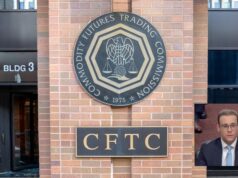In a recent press release, the biggest auction house for art treasures Christie’s announced that from now on its bids and sales will be recorded on a double-layered, blockchain-supported digital database. The latest tour of auctions is the United States: two exhibitions on the West Coast, in San Francisco at Minnesota Street Gallery October 16 – 20, and in Los Angeles at the Beverly Hills Gallery October 23 – 27. The final event will be held in New York, from November 4 to 13 at Christie’s galleries in the Rockefeller Center, wherein an open to the public exhibition the full collection of painting will be shown.
The U.S. auctions include pieces from the private collection of Barney A. Ebsworth, a passionate art collector and a businessman, who gathered highly precious canvases and sculptures in his residence in Seattle. The assemblage named An American Place: The Barney A. Ebsworth Collection, is like a journey through the history of American art in the 20th century. It includes essential for the development of the U.S. art scene painters like Edward Hopper, Georgia O’Keeffe, Jackson Pollock, Willem de Kooning, Jasper Johns, Marsden Hartley, Charles Sheeler, and others. The estimated total revenue of the auctions is about $300 million.
The innovation Christie’s launches is the record on a blockchain database. The introduction of the new feature follows a recent partnership between the auction house and Artory, a digital system for art transactions. Announced on 11th of October, the marriage does not suspend existing certificate scheme of the art dealer but enhances it: from now on, Christie’s will issue physical, as well as digital certificates of purchase.
How can blockchain and art work together?
Artory is a blockchain-based registry of verified information for refined security. It is a decentralized system which records all transactions, provenance of items, information about the piece, history of bids and the final owner. It lets keeping track of the prior artwork and simultaneously, does not save personal data. It uses modern cryptography to trail the life of a collectible through a vetted issuing party which records the valuable information on a data block.
Another important difference is that the blockchain provides anonymity to both the registry and the public. Artory will record all information about a piece’s cycle except personal details. Perhaps, this is the end of the famous art collections.
Nanne Dekking, Founder & CEO of Artory and Chairman of The European Fine Art Fair (TEFAF), stated, according to the partnership announcement that:
Today’s buyers are more skeptical and risk-averse. They want to buy with absolute confidence.
And added that a high-security database is crucial for the contemporary art industry.
Artory was created to be a partner for the art marketplace in addressing these challenges. We support auction houses by enabling them to provide their clients with blockchain-encrypted trust and security, as well as a modern technology experience that buyers expect. Christie’s is an innovator in the industry, and we are thrilled to welcome them as the first collaborator on our trusted network.
The step has been long anticipated by the art world, where frauds, replicas, and thefts are still happening. The blockchain technology can administer painting’s authenticity, proof of origin and all certificates will be permanently recorded on an immutable digital ledger. It also gives transparency and eases the buying process.
However, the technology is yet to be tested. We do not know how the lack of authority, blockchain’s primary advantage, will work in cases of disputes or missing pieces, for instance. And how it will feel to experience art completely through digital processes.











[…] blockchain is now used by Christie’s to record information on artworks. Data like when and where the piece was bought, what is its status, artist, how it was made, etc. […]